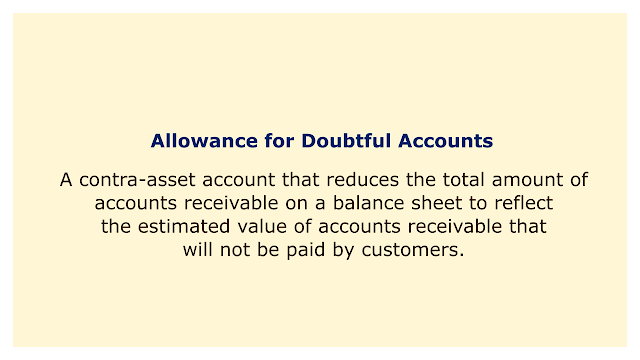 |
| Image: Moneybestpal.com |
A contra-asset account called an allowance for doubtful accounts is used to show the expected value of accounts receivable that customers are likely not to pay for on a balance sheet by reducing the total amount of accounts receivable.
In the same accounting period, it is used to reconcile the costs associated with a sale with the revenue realized. It's an estimate of how much money is owed to a company but cannot be recovered.
Purpose of the Allowance
The allowance for doubtful accounts is used to determine how many clients will not pay their full debt. The business will debit a bad debt expenditure and credit an allowance for doubtful accounts rather than waiting to see exactly how payments turn out. This complies with the matching principle of accounting by guaranteeing that costs associated with the sale are recorded during the same accounting period during which revenue is collected. Companies can estimate the true worth of their account receivables with greater accuracy thanks to the provision for doubtful accounts.
How to Estimate the Allowance
Two primary methods exist for estimating the dollar amount of accounts receivables not expected to be collected:
- The percentage of sales method: This approach calculates the bad debt charge as a proportion of the period's credit sales. For instance, if a business sells goods on credit for $100,000 and anticipates that 2% of those sales will be uncollectible, it will record a bad debt expense of $2,000 and a provision for doubtful accounts of $2,000 in its books.
- The accounts receivable aging method: The age of each account receivable is used in this method to determine the bad debt expenditure. The likelihood of collecting an account receivable decreases with age. If a business has $100,000 in accounts receivable and believes that 5% of those accounts are uncollectible if they are older than 30 days, 10% if they are older than 60 days, 20% if they are older than 90 days, and 50% if they are older than that, it will determine the allowance for doubtful accounts as follows:
 |
| Image: Moneybestpal.com |
The company will then record a bad debt expense of $14,000 and an allowance for doubtful accounts of $14,000.
How to Write off an Account
The business is required to write off an account as uncollectible when a customer refuses to pay an account receivable that was previously recorded as revenue. The business will credit the accounts receivable and debit the provision for dubious accounts to achieve this. The accounts receivable and the provision for doubtful accounts will both be decreased in the same amount as a result, leaving the net realizable value of the accounts receivable unaffected. As an illustration, if a client owes $1,000 and files for
bankruptcy, the business will write off the debt as follows:
 |
| Image: Moneybestpal.com |
How to Recover an Account
A consumer who had previously defaulted on an account might occasionally afterwards pay all or part of the balance due. In this situation, the business must undo the write-off entry and record the cash receipt. In order to achieve this, the business will first debit cash and credit accounts receivable for the amount recovered, then it will debit accounts receivable and credit the allowance for doubtful accounts for the same amount. For instance, if a client who owing $1,000 and was written off later pays $500, the business will record the recovery as follows:
 |
| Image: Moneybestpal.com |




